Roundhay
Roundhay is a large suburb in north east Leeds, West Yorkshire, England. Roundhay had a population of 22,546 in 2011.[1]
| Roundhay | |
|---|---|
Canal Gardens, Roundhay Park | |
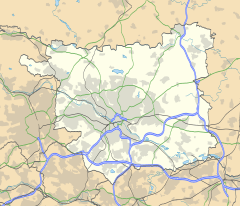 Roundhay 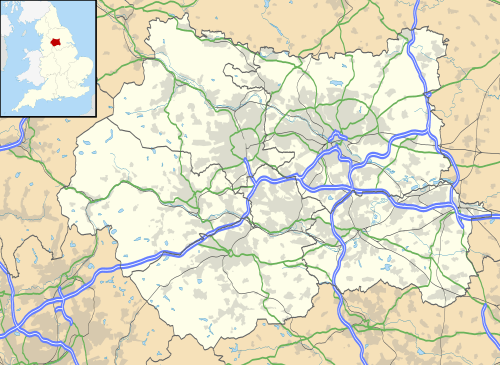 Roundhay Location within West Yorkshire | |
| Population | 22,546 |
| OS grid reference | SE331373 |
| Metropolitan borough | |
| Metropolitan county | |
| Region | |
| Country | England |
| Sovereign state | United Kingdom |
| Post town | LEEDS |
| Postcode district | LS8 |
| Dialling code | 0113 |
| Police | West Yorkshire |
| Fire | West Yorkshire |
| Ambulance | Yorkshire |
| UK Parliament | |
It sits in the Roundhay ward of Leeds City Council and Leeds North East parliamentary constituency.
History
Roundhay's name derives from Old French rond 'round' and the Old English word (ge)hæg 'enclosure', denoting a round hunting enclosure or deer park.[2][3] The Roundhay estate map of 1803 showed its circular shape.[4] It does not appear in the Domesday Book of 1086, but seems to have been formed soon afterwards, the first mention being in about 1153.[2] It was formerly a hunting park for the De Lacy family of Pontefract Castle. Coal and iron ore were mined and a smelting furnace was recorded in 1295.[2] Once these were exhausted (and woodland had been cleared for fuel) the area turned to farming.
Roundhay was historically a township in the ancient parish of Barwick in Elmet, except for a small area in the east around Roundhay Grange (originally a grange of Kirkstall Abbey), which was a detached part of the township of Shadwell in the parish of Thorner.[5] Roundhay was a hamlet until 1803 when the park estate was bought by Thomas Nicholson who started a programme of landscaping and built the Mansion House. Housing was built for workers and more land sold on which other gentry built houses.[2]
Until 1810 Gipton Wood was Gibton Forest separating Leeds from Roundhay Park and a turnpike road was constructed "from Sheepscar to Roundhay Bridge".[6][7] After the road was built the population increased from 84 in 1801 to 186 in 1822, mainly in grand houses for wealthier citizens of Leeds.[6]
In 1826 St John's Church was established to serve the population of Roundhay, Shadwell and Seacroft, a combined population of about 1100, who would otherwise have had to travel up to three miles to worship.[6] This made the area more attractive, the population rose to 300 in the 1830s in the form of a "township and genteel village" with "elegant villas, walks and plantations".[2][6]
In 1866 Roundhay and Shadwell both became separate civil parishes.[8]
In 1872 Roundhay Park estate was purchased by the City of Leeds and opened as a public park by His Royal Highness Prince Arthur on 19 September 1872.[9] At the time, there was much opposition as many considered the park was too far out of Leeds for the majority of the population to enjoy, and the park had just one access road and led to the park being dubbed a 'white elephant' in its early years.[10]
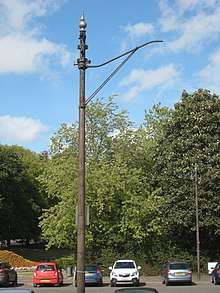
However, there was interest in developing housing, and a suburb began to develop around Lidgett Park.[11] Development was accelerated in 1848 by the provision of a horse-drawn public omnibus service between Leeds and Roundhay Park, then a horse-drawn tram, and on 11 November 1891 the first public electric tram service, which by 1894 provided a quarter-hourly service from 6 a.m.[6] The city sold surplus land, but placed restrictions in its use, stipulating stone for building and the prohibition of offensive trades.[2]
The area acquired a Post Office in 1868 and by the start of the 20th century some parts were lit by electricity. Brick-built detached and semi-detached housing was created along new roads such as The Avenue. In 1888, Louis le Prince recorded his short film Roundhay Garden Scene, which is believed to be the oldest surviving film in existence. In 1901 a second Anglican Church and in 1902 a Congregational Church were established to provide worship within walking distance for the new working class population.[11][12] Lidgett Park Wesleyan Church followed in 1906.[2]
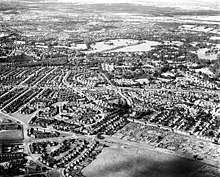
In June 1907 an open-air swimming pool or 'lido' opened, at a cost of just over £1,600, built mainly by unemployed citizens. During the 1950s and 1960s about 100,000 people a year visited the Roundhay 'swimming baths'.[4] In 1912, the civil parishes of Roundhay and Shadwell were abolished, and Roundhay became part of Leeds.[8]
During the First World War Roundhay was used as a gathering place for soldiers, hence land by Prince's Avenue is known as Soldiers Field. After the war, new estates were built to the south and west of the park. Roundhay School for Boys was opened in 1926, and the School for Girls in 1932. After the Second World War housing filled available spaces, with smaller residences built in the grounds of larger ones, and large converted to flats.[2]
Roundhay was the location of the world's first (experimental) film, Roundhay Garden Scene, which was shot on 14 October 1888 by Louis Le Prince in the garden of Oakwood Grange, the home of his parents-in-law, Joseph and Sarah Whitley, (the parents of John Robinson Whitley).
Mansion House and large houses
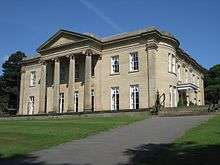
In 1811, John Clarke (died 1857) of York, architect of the Commercial Buildings in Leeds city centre, was commissioned by Thomas Nicholson to design the Mansion House. It was built in ashlar stone in classical Georgian style; of two storeys with seven bays, the centre three set behind an iron portico. It was one of Clarke's early works. For a country house, it is of modest size, but elevated to command views southwards over the park, and provides a focal point to Thomas Nicholson's designed park landscape. The Mansion House stood empty for many years after the departure of catering firm, Gilpin's. Events and catering company 'Dine' was appointed by Leeds City Council to run the Mansion, and in 2009, after refurbishment and gaining a civil ceremony licence, the Mansion re-opened to the public. The venue contains a restaurant and cafe, and hosts private functions.[13]

From the early 1800s, a number of farming estates with large houses were built in Roundhay and some houses are now grade II listed; The Mansion at Roundhay Park (c. 1811), Elmete Hall (1865) and Beechwood (c. 1820).[14] In 1873, architect George Corson won a competition to design a number of substantial villas along Park Avenue, "the jewel in Leed's crown", and West Avenue on the fringe of Roundhay Park. The villas were built on plots of an acre or more with separate coach houses, stables and servants' quarters at the back so as not to be seen from the park. Woodlands Hall (known originally as Roundhay Mount and later as Carr Head), Parc Mont and several other mansions along Park Avenue are architecturally significant.[15]
Roundhay Park

Roundhay Park (2.8 km²), is a Victorian park, the second largest city park in Europe after the 'Englischer Garten' (3.7 km²), in Munich, Germany.
Roundhay Park comprises more than 700 acres (2.8 km2) of parkland, lakes and woodland. The park has scented gardens for the blind, National Plant Collections, Canal Gardens, the Monet and Alhambra Gardens and Tropical World which attracts visitors all year round. In 2005 the Friends' Garden was opened, alongside Canal Gardens and the Rainbow Garden.
Woodpeckers, common warblers in spring and summer, mute swans, visiting whooper swans, great-crested grebes and herons can be found at the park. The Upper Lake is maintained as a wildlife area, and the larger Waterloo Lake is used for fishing. Roundhay Park provides the venue for special events including sporting events, flower and animal shows, music festivals and a bonfire and firework display on 5 November, (Guy Fawkes Night).
Facilities include tennis courts, skateboard ramps, sports pitches, bowling greens, a sports arena, a golf course and fishing. A cafe overlooking Waterloo Lake was damaged by fire in 2007 but restored and re-opened in 2008.[16]
Roundhay Park was the first place an aircraft landed in Leeds, after a flight from Amsterdam in the Netherlands. The Park went on to have its own aerodrome with one of the earliest air passenger services comprising regular flights every half hour to Bradford. Aircraft were manufactured at the nearby Olympia aircraft works opened by Thomas Blackburn in 1914. The aerodrome operated until 1920. The factory continued until the 1960s, the previous factory site now being occupied by a large Tesco supermarket.
Tropical World is located to the west of the park and contains many rare birds and butterflies.
The park has hosted numerous outdoor concerts including Michael Jackson, The Rolling Stones, Bruce Springsteen, Robbie Williams and Ed Sheeran.
Sport and culture
Leeds Carnegie RUFC was founded after the merger of the Headingley and Roundhay Rugby Union clubs. Roundhegians RFC was the old boys' association of Roundhay School but now operate as a rugby club for the whole of Roundhay. The club plays at Chelwood Drive at the west end of Roundhay, near Moortown. Leeds Golf Club "Cobble Hall" as it is more affectionately known locally is situated on the edge of Roundhay park it has The Leeds Cup - The Oldest Trophy in Professional Golf Worldwide. The famous golf architect Doctor Alastair MacKenzie was a member of Leeds Golf Club between 1900 and 1910. There is also Roundhay Golf Club within Roundhay Park which is reputably designed by Dr MacKenzie and has a restaurant ("Del Verde").
Amenities

There are several public houses on Street Lane (Deer Park, Thomas Osborne and Roundhay Fox), a Co-op, a Wine Rack off-licence, Sainsburys Local, and numerous restaurants including San Carlo Flying Pizza (Italian); Banyan Bar/Restaurant; Pizza Express; Aarti (Indian restaurant); ECCO Pizza and Del Verde (in Park Lane). There are several take-away's including Domino's Pizza, Fryday's Fish & Chips; Canton Flavour and on the Talbot parade Harpo's Pizza and Bengal Spice. There is also an award-winning deli (Hayley & Clifford), florist (Daisy Chain), Share Jewellers, Texaco filling station, a Starbucks coffee shop, a bookmaker, charity shops and other small retailers. Near Oakwood Clock there is a larger Tesco store. Other areas have corner shops. The local centres in Moortown and Chapel Allerton are close by. Roundhay has a private hospital. Roundhay School and Allerton Grange School have been rebuilt along with several primary schools in Roundhay and Gledhow.
The area is served by First West Yorkshire circular services 2 (via Chapel Allerton) and 12 (via Harehills) from Leeds city centre. These operate at a 10-minute frequency during the daytime on weekdays and Saturdays, and 30 minute frequency on evenings. Daytime frequency on Sundays is 20 mins.[17] The closest main line rail station is Leeds (approx 4.5 miles).
Housing
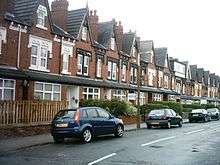
Roundhay has a wide variety of housing. There is a mixture of Victorian through terraces, villas and 20th-century detached and semi detached housing. Because there has never been any mass house building in Roundhay at any one time, there is no consistent style throughout the area. There are many Victorian villas and flats adjacent to the park and along the northern edge of Roundhay.
Religion
According to the 2011 census[18] 22,546 people were counted, of whom 46.64% gave their religion as Christian, 25.60% as No religion, 7.40% religion not stated, 12.58% Muslim, 1.89% Jewish, 3.40% Sikh, 1.78% Hindu, 0.34% Buddhist, 0.35% Others.
The first post-Reformation Catholic church in Leeds was the Roundhay Mission.[19]
The Rev. Thomas Davis, a Church of England hymn-writer, was Vicar of Roundhay in the mid 19th century.
 St Edmund's Parish Church, junction of Lidgett Park Road and North Park Avenue, Anglican
St Edmund's Parish Church, junction of Lidgett Park Road and North Park Avenue, Anglican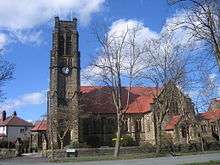 St Andrew's Church, Devonshire Crescent, United Reformed
St Andrew's Church, Devonshire Crescent, United Reformed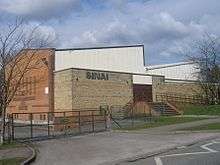 Sinai Synagogue, Roman Avenue
Sinai Synagogue, Roman Avenue Quaker Meeting House, Street Lane
Quaker Meeting House, Street Lane
- All Nations Community Church
- St Johns CE Church (Closed June 2008)
- St Edmunds CE Church
- Lidgett Park Methodist Church
- Oakwood Church joint Methodist and Anglican
- St Andrew's URC Church
- Roundhay Evangelical Church
- Society of Friends (Quakers)
- Sinai Synagogue
Education
- Allerton Grange High School
- Roundhay School
- Gledhow Primary School
- Talbot Primary School
- Kerr Mackie Primary School
- St. John's Church of England Primary School, Roundhay
Location grid
References and notes
- http://ukcensusdata.com./roundhay-e05001440#sthash.QhHgCFE7.dpbs
- West Yorkshire Archaeology Advisory Service Archived 12 October 2007 at the Wayback Machine Roundhay Park Conservation Area; Victor Watts (ed.), The Cambridge Dictionary of English Place-Names Based on the Collections of the English Place-Name Society (Cambridge: Cambridge University Press, 2004), s.v. ROUNDHAY.
- A circular fence requires the minimum length to enclose any given area, reducing the materials and work required
- Steven Burt (2000) Roundhay Park - an illustrated history
- "Roundhay Park Conservation Area" (PDF). West Yorkshire Archaeological Advisory Service. 2007. Archived from the original (PDF) on 7 April 2014. Retrieved 6 April 2014.
- J. Dickinson & G.D. Webster (1967) A History of St John's Church Roundhay
- Roundhay Bridge was near the Lido Car Park on Wetherby Road
- Vision of Britain: Roundhay CP/Tn
- Daily News 20 September 1872 Prince Arthur at Leeds
- See various issues of the Leeds Mercury in 1871 and 1872
- St Edmund's Parish Church History Archived 23 October 2008 at the Wayback Machine
- St Andrew's Story
- http://www.roundhaytoday.co.uk/sectionhome.aspx?sectionID=10615
- LDF Team, Leeds City Council. "Roundhay Ward Neighbourhood Design Statement" (PDF). UK Gov. City of Leeds - 2010. Retrieved 31 May 2015.
- LDF Team, Leeds City Council. "Roundhay Ward Neighbourhood Design Statement" (PDF). UK Gov. City of Leeds - 2010. Retrieved 31 May 2015.
- Yorkshire Evening Post 17 June 2008 "Cheers all round as lake cafe re-opens"
- First Leeds
- UK Census Data Roundhay
- Roundhay (RC) Mission, accessed 30 November 2017
External links
| Wikimedia Commons has media related to Roundhay. |
| Wikivoyage has a travel guide for Roundhay. |